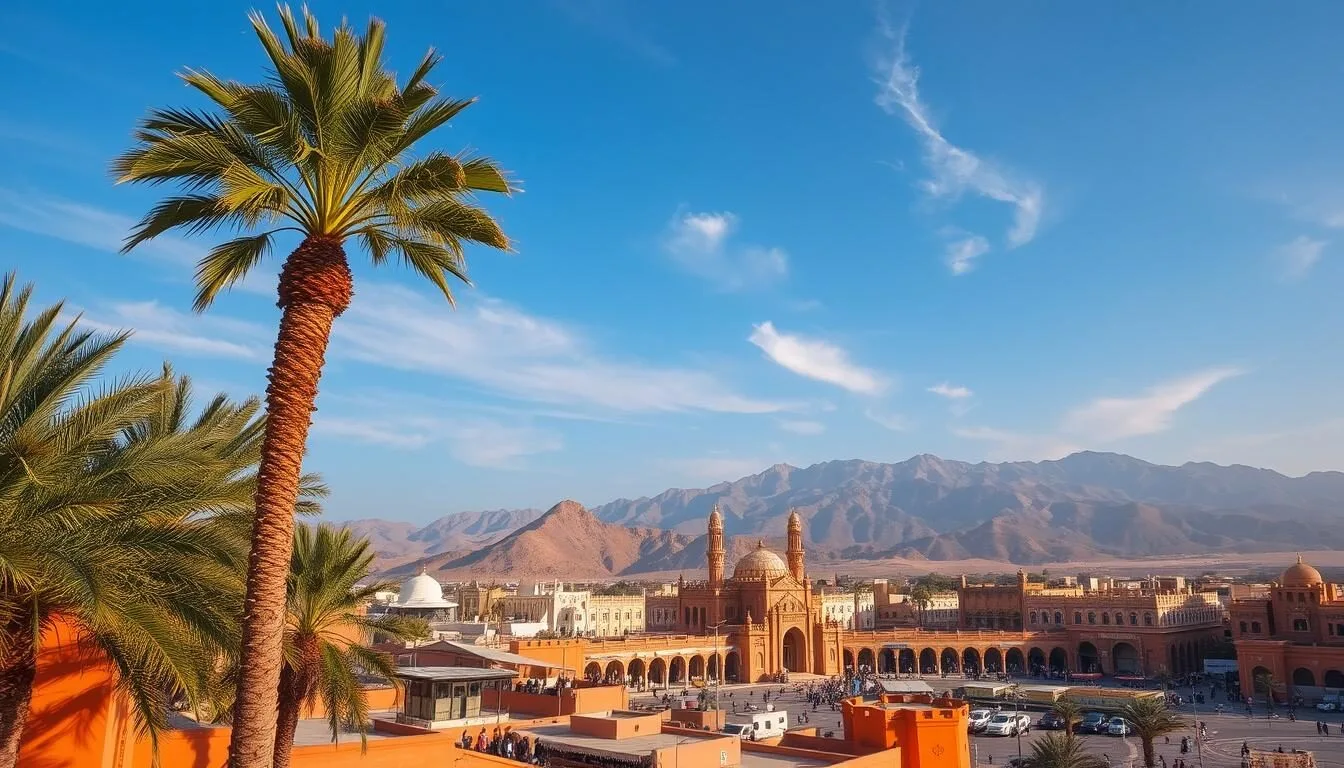✓ Accommodations✓ Flights✓ Rental Cars✓ Tours & Activities
Did you know that timing is everything when planning your trip to Muscat? Choosing the right season can transform an ordinary vacation into an unforgettable adventure. Oman’s diverse landscapes offer something for everyone, from bustling streets to serene beauty.
The country’s temperatures range from pleasantly warm to scorchingly hot, depending on when you visit. To make the most of your trip, understanding the local weather patterns is crucial.
Visiting between October and April offers the most comfortable weather for exploring cultural treasures and natural wonders. By planning your trip during these months, you’ll be able to enjoy the authentic charm of Muscat while experiencing comfortable exploration conditions.
Understanding Oman’s Climate and Weather Patterns
The climate in Oman is as diverse as its landscapes, ranging from hot deserts to cool mountains. This diversity is a result of the country’s unique geography, which includes coastal areas, mountains, and deserts.
Muscat’s Year-Round Weather Overview
Muscat, the capital city of Oman, experiences a hot climate throughout the year. Summer temperatures often soar, while winters are generally mild. The average temperature in Muscat varies significantly between summer and winter, making it essential to plan your visit accordingly. During the summer months, the temperature can reach extremely high levels, whereas in winter, it remains relatively mild.
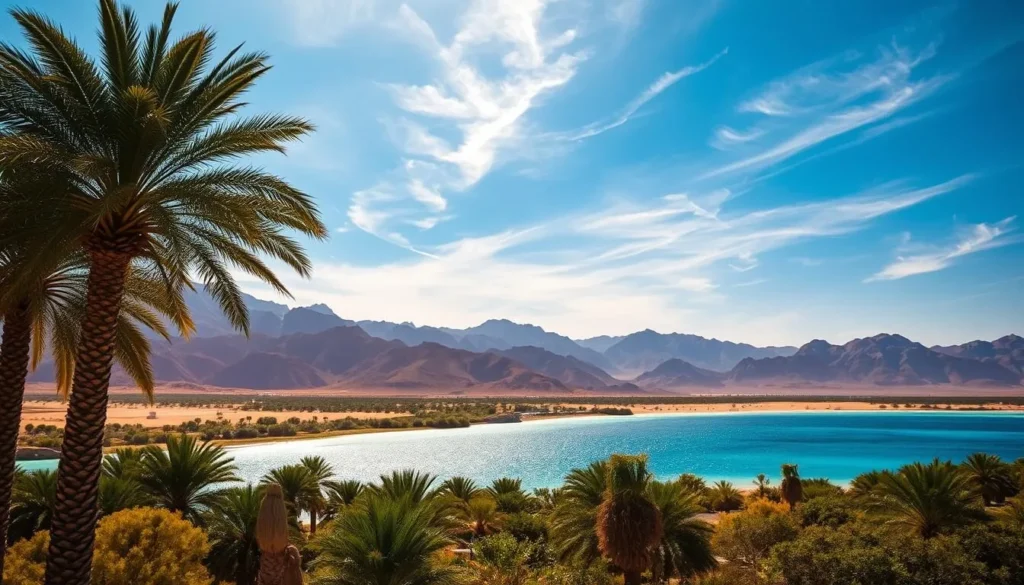
Regional Climate Variations Across Oman
Oman’s climate varies significantly across different regions. The Hajar Mountains, for instance, maintain cooler temperatures throughout the year compared to the coastal areas like Muscat. In the mountains, you can expect average daytime highs around 68°F during winter, dropping to 50°F at night. Even in summer, daytime temperatures rarely exceed 85°F. In contrast, the interior deserts experience extreme temperature variations, with scorching days and cool nights, especially during winter.
Other regions, such as the Dhofar area around Salalah, experience a unique climate due to the Khareef monsoon season from June to September, bringing misty conditions and lush greenery. Understanding these regional variations allows you to plan your trip to experience optimal weather conditions across different parts of the country.
The Ideal Season: October to April
Travelers to Muscat often seek the best time to visit, balancing comfortable weather with tourist activities. The period from October to April stands out as the ideal season for a visit, offering pleasant temperatures and a range of outdoor activities.
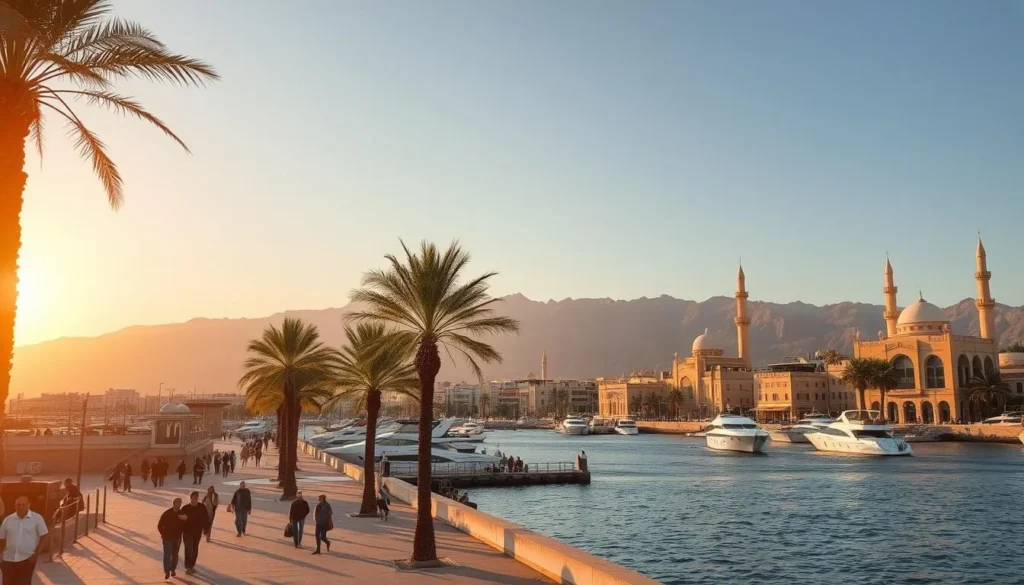
Winter Months: December to February
The peak tourist season in Muscat is during the winter months, from December to February. These months offer the most comfortable weather, with average highs around 75°F (24°C), making it perfect for exploring the city’s attractions and enjoying outdoor activities like desert safaris and visits to the Muscat coastline.
During this period, you can enjoy a wide range of cultural events and festivals, enhancing your travel experience. The pleasant weather also makes it an ideal time for activities such as hiking in the nearby mountains or simply enjoying the beaches.
Shoulder Seasons: October-November and March-April
If you’re looking for a balance between comfortable weather and fewer crowds, consider visiting during the shoulder seasons of October-November or March-April. These periods offer temperatures ranging from 86-95°F (30-35°C), which are still manageable for most outdoor activities.
- The shoulder seasons provide a good balance of comfortable weather and lower prices compared to the peak winter months.
- October-November sees temperatures cooling down from the summer highs, while March-April experiences a gentle warming before the onset of summer.
- These periods are particularly advantageous for budget-conscious travelers, with lower hotel rates and better availability at top accommodations.
- Spring, in particular, is a beautiful time to visit, with the Hajar Mountains blooming with damask roses and fruit trees, creating spectacular displays of color.
Visiting during the shoulder seasons allows you to enjoy Muscat’s attractions with fewer crowds, making for a more relaxed experience. The slightly warmer weather also makes beach activities and swimming particularly enjoyable along Muscat’s coastline.
Summer in Muscat: What to Expect
The summer season in Muscat is characterized by high temperatures, but it also offers some unexpected advantages. If you’re planning to visit Oman during the summer months, it’s crucial to be prepared for the heat.
Dealing with the Heat: May to September
During the summer, Muscat experiences extremely high temperatures, often reaching above 40°C (104°F). To make the most of your trip, focus on indoor activities or water-based activities during the peak heat hours. Many hotels and resorts offer luxurious amenities to help you relax and cool off.
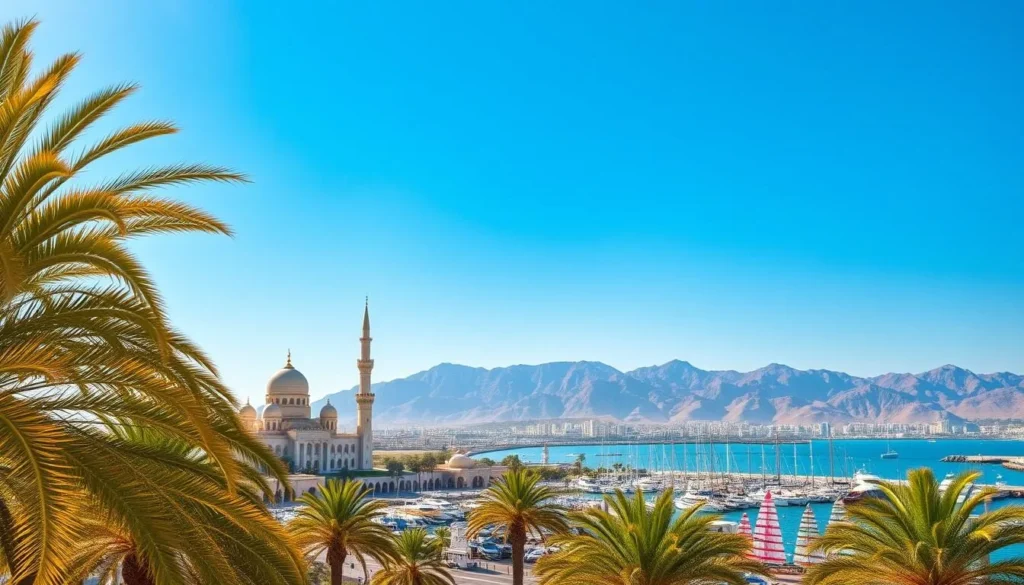
Surprising Benefits of Summer Travel
Despite the challenging weather, summer travel to Muscat has its perks. You can enjoy significant discounts at luxury hotels, with some properties offering rates reduced by as much as 40-50% compared to winter prices. With fewer tourists around, you’ll have a more authentic experience at popular attractions and beaches.
Summer evenings can be pleasant for outdoor dining and waterfront activities. Many hotels offer special summer packages, including spa treatments and dining credits. The season also coincides with mango season in Oman, offering a chance to savor local fruits at their peak ripeness.
By understanding what to expect during the summer months, you can plan a memorable trip to Muscat, taking advantage of the unique opportunities it offers.
## Muscat, Oman: Best Months for a Weather-Savvy Trip
When planning a trip to Muscat, Oman, understanding the best time to visit is crucial for a comfortable and enjoyable experience. The city’s climate varies significantly throughout the year, making some months more suitable for travel than others.
Peak Season vs. Off-Season Considerations
The best time to visit Muscat is from October to April, when the weather is mild and pleasant. During these months, the temperatures are comfortable, making it ideal for outdoor activities and sightseeing. The peak tourist season is from December to February, with January being one of the coolest months. In contrast, the off-season, characterized by extremely high temperatures, makes outdoor activities challenging.
Month-by-Month Breakdown
Here’s a breakdown of what to expect each month:
- January: Ideal weather with temperatures ranging from 75°F to 80°F (24°C to 27°C).
- February: Similar to January, with perfect daytime temperatures and slight chance of brief rain showers.
- March: Temperatures begin to rise, reaching the mid-80s to low 90s Fahrenheit (29°C to 32°C).
- April: Increasingly warm, with temperatures often exceeding 90°F (32°C).
- October: Comfortable temperatures return, ranging from 80°F to 90°F (27°C to 32°C).
- November: Pleasant conditions continue, with temperatures in the 80s (°F).
- December: Ideal weather returns, with temperatures between 75°F and 80°F (24°C to 27°C).
Seasonal Activities and Attractions in Muscat
Muscat, the capital of Oman, is a city that offers a wide range of activities and attractions for visitors throughout the year. From cultural events to outdoor adventures, there’s something for everyone in this vibrant city.
Winter Activities
During the winter months, Muscat comes alive with cultural events and festivals. The Muscat Festival is a highlight, showcasing local art, music, and cuisine. Visitors can enjoy traditional markets, amusement parks, and amusement rides, making it a great time for families.
Special Events and Festivals Throughout the Year
Muscat hosts various events throughout the year, including the Muscat International Film Festival, which brings global cinema to the city. The Muscat Marathon is another significant event, attracting runners from around the world. Additionally, the city’s National Day celebrations on November 18th mark Oman’s independence with parades, fireworks, and cultural performances.
Beyond Muscat: Weather Considerations for Popular Destinations
Oman’s varied regions offer a wealth of experiences that go far beyond the capital city. As you plan your trip, considering the weather in other popular destinations can help you make the most of your visit.
Salalah and the Khareef Season
Salalah, located in the southern region of Oman, transforms during the Khareef season, which typically occurs from June to September. This period is characterized by a lush, green landscape and cooler temperatures, making it an attractive time to visit.
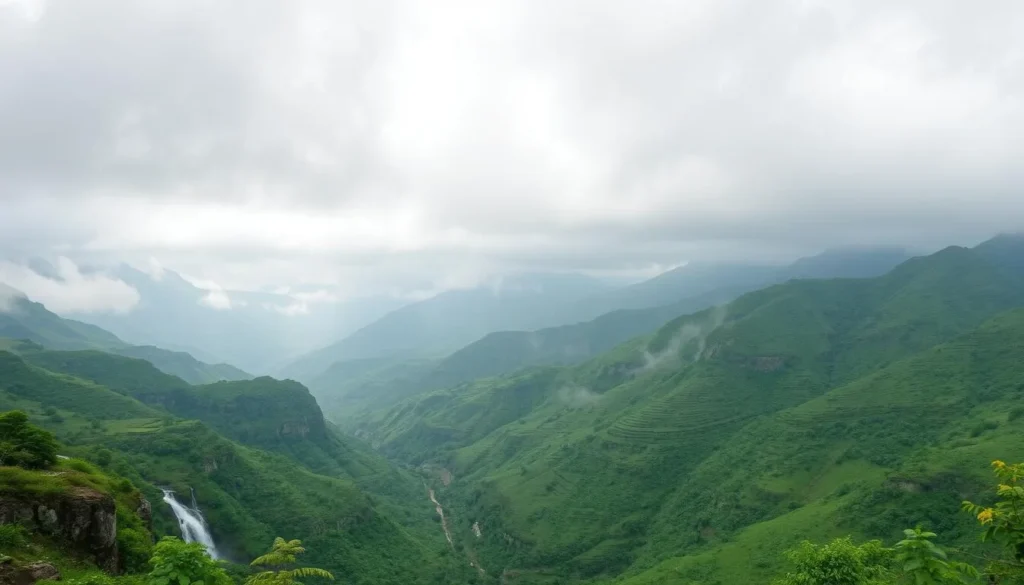
The Khareef season brings a unique climate to Salalah, with misty mornings and mild temperatures, averaging around 25°C (77°F). It’s an ideal time for outdoor activities like hiking and exploring the city’s natural attractions.
Jebel Akhdar and the Hajar Mountains
The Hajar Mountains, including Jebel Akhdar and Jebel Shams, offer a cooler climate year-round compared to Muscat. Jebel Akhdar, meaning “Green Mountain,” lives up to its name during early summer when thousands of damask roses bloom.

During winter, temperatures in the mountains can drop significantly at night, while daytime temperatures remain pleasant. Spring brings stunning pink landscapes as the damask roses bloom. Summer provides a refreshing escape from Muscat’s heat, with temperatures 8-11°C (15-20°F) cooler.
Practical Travel Tips for Weather-Savvy Visitors
When traveling to Oman, being prepared is key to a enjoyable trip. Here are some practical tips to consider.
What to Pack for Different Seasons
Pack light, breathable clothing for the hot summer months. For the cooler winter months, layers are recommended. Modest clothing is respectful, especially when visiting mosques or government buildings.
Navigating Cultural Considerations
During Ramadan, avoid eating, drinking, and smoking in public during daylight hours. Dress modestly and be respectful of local customs.
Conclusion
Muscat, Oman, offers a unique experience throughout the year, but the weather and activities vary significantly from season to season. The best time to visit Muscat is during the winter months from October to April, when pleasant temperatures create ideal conditions for exploring this fascinating country.
Your trip planning should consider not just avoiding extreme heat but also aligning with specific activities – whether desert adventures, mountain hiking, or experiencing the unique Khareef season in Salalah. Budget-conscious travelers can find exceptional value during shoulder seasons (October-November and March-April), balancing good weather with lower prices and fewer tourists.
By understanding the seasonal variations and planning accordingly, you can make the most of your trip to Muscat. Whether you’re drawn to Muscat’s historic forts, the majestic Hajar Mountains, pristine beaches, or vast desert expanses, timing your visit wisely will help you experience the best this extraordinary country has to offer.
Proper preparation, including packing appropriate clothing and planning daily activities around weather patterns, ensures your Muscat adventure will be memorable. Respecting local customs and being mindful of the time of year will enhance your interactions with Oman’s welcoming people.
—
The above is subject to change.
Check back often to TRAVEL.COM for the latest travel tips and deals.
